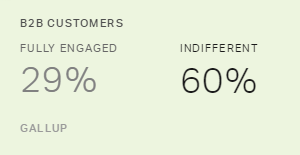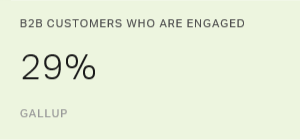An ongoing challenge for business-to-business (B2B) companies is to achieve organic growth -- that is, to get more business from existing customers. This problem is made immensely more difficult by the fact that so few B2B customers -- only 29% -- are fully engaged. The remaining are either indifferent (60%) or actively disengaged (11%). Customers who aren't engaged don't look to deepen their relationships with B2Bs.
There are many solutions to this problem, and Gallup has discovered that a major one is greater collaboration between B2Bs and customers.
Here's an example. The CEO of a large consumer goods company relayed a story to Gallup executives about a sales team of which he was once a part. As a member of that team, he met with the founder and leader of a major retailer. The retail leader commented that their respective companies had a great relationship, but that it was shaped too much like a bow tie.
What did he mean? From the retail leader's perspective, the retailer's procurement team and the consumer goods company's sales team were at the center of the relationship, leading the majority of the interactions between the two companies. Both teams represented two great companies that didn't fully understand each other, so their relationship didn't take full advantage of each other's value chain and core competencies. In the leader's mind, this structure was not maximizing value for either company.
The retail executive thought that his company's procurement team and the consumer goods company's sales team were too focused on their individual objectives and compensation programs. As a result, the teams were working diligently to achieve their own metrics and personal goals, and they were missing big opportunities for shared benefits, cost savings and growth.
The retail leader's directive was to unknot the bow tie to create a true partnership -- one in which both companies were transparent about costs but allowed each other to make a profit. He also believed this partnership needed top-level leadership support, a formal business plan and a solid structure to maximize time and investment.
Traits of the Best B2B Relationships
That idea of unknotting the B2B bow tie stayed with the consumer goods CEO long after he left the sales department, and it continued to inform his thinking all the way to the C-suite. His story also underpins some of the best B2B relationships Gallup has studied. These relationships show some specific traits, including:
A partnership that starts at the top. In the best B2B relationships Gallup has studied, the client company knows the customer's business and both sides take chances on new ideas, offer transparency and take a long-term view of the relationship. But the partnerships that unknot the bow tie also have an element of "top-to-top" in them: The customer organization's senior executives have a true partnership with the client company's senior leaders. Far too often, the company and customers are economical in small matters but wasteful in large ones because individual incentives and compensation plans create barriers to openness and creativity. Before companies and customers can explore options that might increase cost in the beginning but offer joint value and savings in the long term, senior leaders of both companies must be invested in a beneficial partnership.
A willingness to take chances -- on both sides. Like everything else in business, if there's no risk, there's no return. On the company side, risk means going first, showing value early and making an investment in the relationship before a return is apparent. On the customer side, risk includes entering a long-term relationship that might have higher initial costs but offers much lower long-term costs and increased value over time. Both parties involved know that unforeseeable issues can change the playing field or that key stakeholders on either side could leave. Companies that unknot the bow tie accept those risks if there is a strong probability of a high return on their investment.
A commitment to ongoing transparency. Committing to transparency means that both sides are honest about what they want to achieve, how experienced they are in certain activities and ventures, and what costs and margin requirements they have. When done correctly, clearly revealing intentions creates trust and allows both customers and suppliers to look for win-win opportunities. In every partnership where this level of transparency exists, there is a fundamental understanding that each company is in business to make money and that both businesses should be allowed to earn a living.
A long-term view. Building meaningful relationships -- including customer relationships -- takes time. Customers often make long-term investments, linking their company to a specific supplier for a long time. For companies, winning long-term business can be complicated and risky and can take years. Organizations that unknot the bow tie typically understand the time frame involved and recognize that the payoff on either side might not come this quarter -- or even this year.
A joint, written plan that defines goals and expectations. For partnerships to succeed, they need a formal, joint business plan that details each company's role and responsibilities. These plans specifically describe what each company hopes to gain from the relationship, how long this will take and what expectations exist on each side. Both businesses meet regularly and often as a cross-functional team, allowing team members to share their diverse opinions. This cross-functional team includes executive sponsors, functional managers and day-to-day relationship participants.


